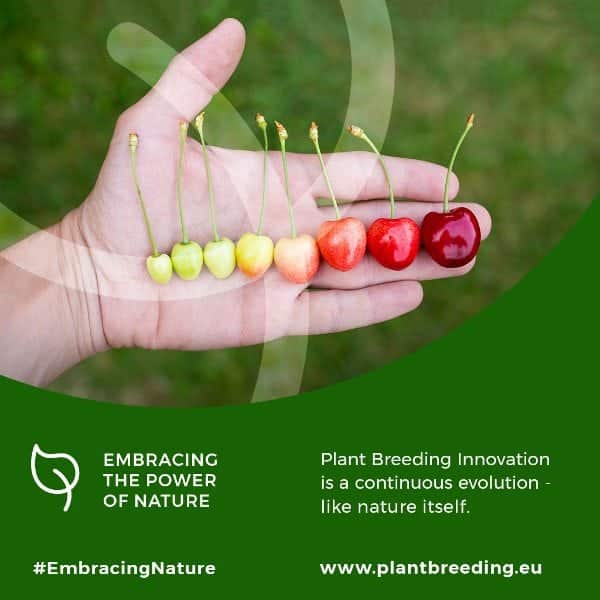In September 2017, the European Seed Association (ESA) launched its new communication initiative ‘Embracing the Power of Nature’, the aim of which is to engage with a wider public interested in learning about plant breeding and latest plant breeding methods. This gave reason for European Seed to sit down with Philip Weiss, ZN CEO to find out more about the need for the Embracing Nature campaign, and how to go about it, developing such a campaign from scratch.
European Seed (ES): Phil, lately there has been a lot of debate on the so-called plant breeding innovation. Why was it important for ESA to engage in communication on this topic?
Philip Weiss (PW): Plant breeding innovation is a complex topic and can easily be misunderstood. Many consumers do not even know the purpose of traditional plant breeding practices. They are not aware of the multiple challenges and risks facing the European agricultural sector and, ultimately, our own food supply. Given upcoming legislative decisions, the industry is facing a big communication challenge: There is very little time to bring decision makers up to speed and explain how plant breeding benefits multiple stakeholders and society as a whole.
[tweetshareinline tweet=”There is very little time to bring decision makers up to speed and explain how plant breeding benefits multiple stakeholders and society as a whole.” username=”EuropeanSeed”]
ES: Some groups in society increasingly seem to be reluctant to embrace new innovation. What is driving that and how can we change that?
PW: My personal opinion is that these trends are worrisome for society. As communication experts in the digital space, we can see growing skepticism among consumers, leading to the growth of such movements. These often reinforce people’s fears and emotions about an issue rather than inviting them to understand the wider context and facts. Many of these movements are highly emotional and foster extreme opinions, rejecting science and fact-based discussion.
With complex topics like health and our food supply system, this increasingly leads to misinformation. Too many people base their personal judgements on anecdotes and isolated stories. As a concerned citizen and parent, I feel it is important to help scientists step up, engage with a wider audience and correct these misconceptions.
[tweetshareinline tweet=”Too many people base their personal judgements on anecdotes and isolated stories.” username=”EuropeanSeed”]
Only informed citizens can make informed decisions and only those who know the facts can help other citizens understand the wider context of these relatively complex issues, and challenge those who try to demonize innovation and new technologies.
ES: Social media on many topics has been filled with highly emotional people that spread misinformation and cultivate fear. From a psychological standpoint why is it that mankind is sometimes so easily swayed towards such doom-laden messages, despite the fact that the facts say otherwise?

According to recent studies about the impact of fake news on the US election and elsewhere, it is clear that ‘fake news’ travels fast. Social media have created a platform that gives us unprecedented access to information on any conceivable topic, at the touch of a finger, on a device you can carry in your pocket. With this information, people don’t take the time to verify the accuracy of the information they consume. Speed and emotion overtake quality and depth every time.
[tweetshareinline tweet=”People don’t take the time to verify the accuracy of the information they consume. Speed and emotion overtake quality and depth every time.” username=”EuropeanSeed”]
People are attracted to information that they agree with and social media platforms are designed to get us to spend as much time as possible on the different digital channels. The more we click, the more money they earn. The impact of this new information architecture is that we are less critical and less informed now than when our choice was more limited and more ‘controlled’ by editors and experts.
However, it is wrong to think that this information platform caters only to negative messages of doom and gloom. Social networks increasingly reflect – and sometimes magnify – society as it is. This means that you can find all different shades of opinion expressed. But because this has become a critical – if not the critical – channel in shaping opinion, it is vital for any organisation to be present and active in those channels in order to make its voice heard.
ES: You have helped ESA in their campaign, #EmbracingNature. How did you go about it developing this campaign?
PW: We started by going into the field and meeting plant breeders to understand their challenges. We then looked at the online landscape on this topic, to identify common misconceptions, define the best way to engage and give a constructive and coherent narrative around the topic of plant breeding innovation.
From there, and together with ESA, we helped develop the umbrella theme Embracing Nature. We identified key topics like the purpose and history of plant breeding, food quality, European food supply and resource-efficient farming as being useful for communicating about plant breeding innovation to a general public.
We then worked with ESA members to explore issues and topics that we could talk about.
ES: At the start of the project, you have gone into the field and met with plant breeders. What were some of the eye-opening revelations that you came across?
PW: For our team, exploring the world of plant breeding innovation was like getting access to a fascinating and important area that is often misunderstood. Even though we’ve already worked in the agricultural sector for many years, we were impressed with the possibilities plant breeding innovation can offer and with the industry’s importance for the agricultural sector.
The plant breeders we met were extremely competent in their field of expertise, but often were not actively engaging in communicating about these very important topics. We are convinced it is very important for scientists in the food and agricultural sector to develop the skills to communicate on the topics they work on and help rectify misconceptions around such a vital industry.
ES: What kind of tools and outreach have you started using, and why was this necessary?
PW: Like in many other industries across the food supply chain, the key challenge is that conversations around plant breeding on social media are often dominated by organisations that are against innovation and investment in science. Some of these organisations use highly emotional messages to persuade the public of their views.
In order to prepare the Embracing The Power Of Nature campaign, we mapped the online activities of different stakeholders, influencers and decision makers. Based on their level of activity and their conversations, we decided to use Twitter and Facebook as key channels for the campaign.
Today we work closely together with the ESA team to make the most effective use of the information available, leverage events for social media activation and help put complex scientific concepts into simple content that a general audience can understand.
ES: Why was social media the preferred starting point for this campaign, as opposed to brochures, video interviews, and other tools?
PW: From our research, we found that social media was the space where most people are discussing the topics and issues that matter to the industry, and that being present could have the biggest impact on the conversation.
We believe that it is vital to understand how critical social media is to this conversation. This will help us speak about the importance of plant breeding innovation and tackle the issue where common misconceptions are created whilst providing context and facts.
Social media conversations will happen with or without ESA. In order to lead a constructive, open and fact-based dialogue about the future of plant breeding, it was crucial for ESA and its members to become active on channels like Twitter and Facebook.
ES: How can ESA members help in spreading this message?
PW: The more voices there are, the better. With this campaign we want to create a balanced and truly European narrative that gives a voice to the plant breeding sector and encourages more scientists to speak out to rectify common misconceptions about plant breeding innovation.
Many ESA members are already active on Facebook and Twitter and we see that the conversation is taking shape. Those that have yet to take that step and join the online dialogue are welcome to join the conversation by telling their side of the story on social media and using the hashtag #EmbracingNature.
ES: Now that ESA and its members are ‘filling the space’ with positive messages about plant breeding and its innovation, what would be the next steps?
PW: The conversation has to go deeper, and ESA and its supporters need to help the public at large understand the complexity of the issues involved. This initiative will encourage more scientists to engage and express their views on social media. We can then see how to bring industry representatives, scientists and NGOs together to collectively find solutions. The future of our food supply concerns all of us, not only in our organisational roles but also as citizens, family members and individuals. We have to collectively find solutions.
ES: If you could speak to the top EU officials in one room, what would you say to them?
PW: I would tell them they need to be open and honest about the challenges we are facing today.
Politicians and officials are often tempted not to get into a conversation that might be complicated or make them unpopular, even if they believe it is the right thing to do.
[tweetshareinline tweet=”Politicians and officials are often tempted not to get into a conversation that might be complicated or make them unpopular, even if they believe it is the right thing to do.” username=”EuropeanSeed”]
I would say it is time for all of us – and I mean, citizens, industry, politicians and other stakeholders – to have an open and honest conversation about science, innovation and our future. Not by listening to the loudest voices but by engaging with the science community, looking at facts and recognizing the real challenges we face, and looking for the solutions and the right mindset to find these solutions.
We need to engage with those who push negative stories about science and use emotions to drive fear into the public, and invite them to engage with scientists and discuss the wider context.
I believe that with initiatives like ours, this is starting to happen. But I think we need politicians and officials who are willing to have an open, honest and sometimes difficult conversation about these questions. Decision-makers need to put science and facts at the heart of their decisions.
Where on the Web: ZN Consulting https://znconsulting.com/












